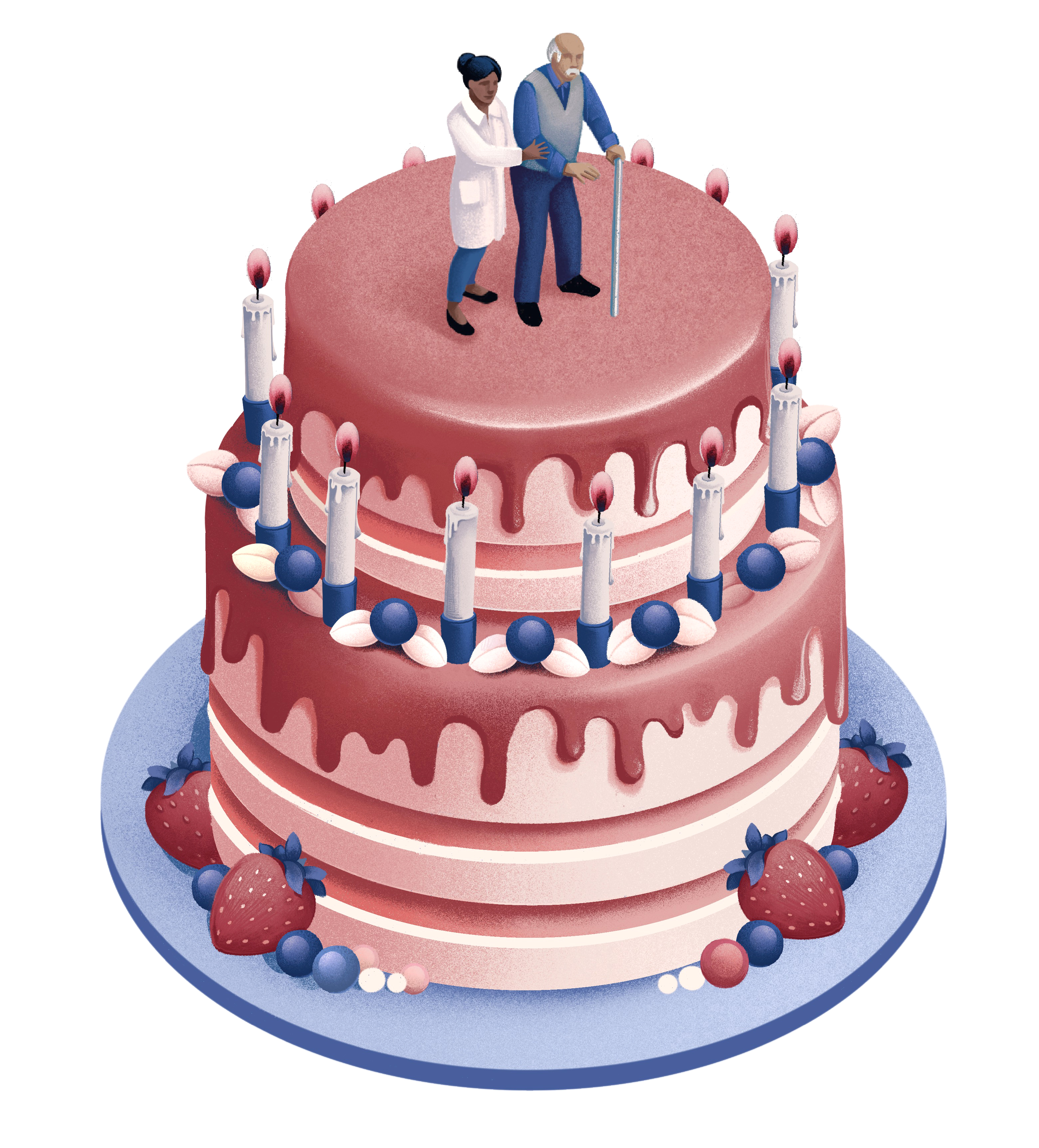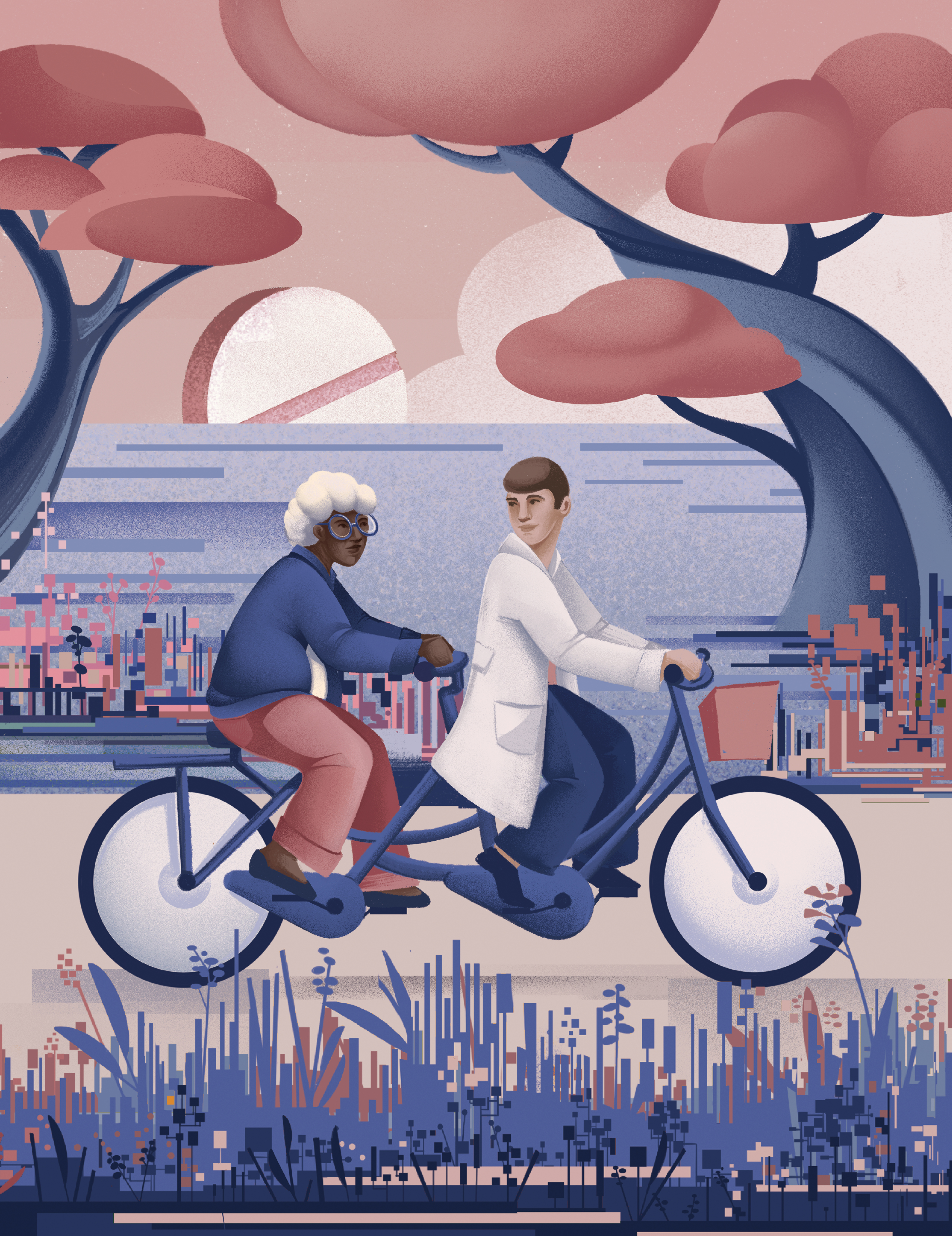Healthy Aging
Jennifer Allford Illustrations by Chiara Vercesi - 27 March 2024

One day you can’t read the menu at your favourite restaurant. Then you realize that the second glass of wine you ordered is taking a much bigger toll than it used to. Your friends start talking about their shingles vaccines, all the women you know are commiserating about seemingly endless hot flashes, and every third pal is getting a hip replacement. Minor injuries take longer to heal. Sleep can be elusive. And suddenly, you have more prescriptions.
It’s all part of getting older. And pharmacists, with their incredibly broad scope of health-care practice, are crucial in helping people along with healthy aging. Their roles vary. They are the clinicians behind the counter at the drugstore, the researchers improving the day-to-day practice of pharmacy as well as the scientists studying biological processes that evolve with the cumulative candles on the birthday cake.
And the number of birthday candles being blown out across the country is growing. Canada’s roughly 9.2 million baby boomers, people born between 1946 and 1964, will soon start turning 80. The oldest of the boomers will hit 85 by 2031. Statistics Canada reports this advancing army of older adults — about one-quarter of Canada’s population — is “gradually putting more pressure on the health- and home-care system.”
This demographic reality highlights the urgent need to do all we can to promote and ease healthy aging. Researchers at the University of Alberta’s pharmacy school — one of the top three schools (in English) in Canada, top 50 around the world and top 15 for global research — are leaders, helping people navigate the process of getting older.
A Holistic View of Aging
It may be instructive to begin any conversation about healthy aging by remembering that everyone at every age — from a newborn baby onward — is, in fact, aging, says Cheryl Sadowski, professor in the Faculty of Pharmacy and Pharmaceutical Sciences and a pharmacist in the Geriatric Outpatient Clinic at Edmonton’s Misericordia Community Hospital.
“We often associate aging in a very negative way as if aging is something that happens when you’re 60. Or we start noticing changes, say in our 40s, with our eyes when we need reading glasses,” she says. “But really, aging is a process that starts when you’re born.”
While we view aging and its accompanying developmental stages as positive when we talk about children or young adults, once you hit a certain birthday, aging tends to be viewed in a more negative light. “We view it as a decline once people are older,” she says. But Sadowski sees it through a different lens: “We can also view it as ‘it’s change.’ It can be positive or negative, but it’s change.”
Sadowski researches geriatric syndromes, medication safety in older adults and deprescribing (reducing or stopping medications that are no longer effective or may be harmful). She’s also spent more than 20 years seeing hundreds of older adults at the Misericordia Hospital’s geriatric clinic in Edmonton. She defines healthy aging as “preventing decline and maintaining function.” Pharmacists, she suggests, have an important role to play helping patients think about their health more holistically — encouraging healthy habits around diet and sleep, promoting social interactions and suggesting how older adults can keep their brains and bodies active.
“I think we’ve really medicalized aging and focused just on the physical changes that happen,” she says. “Aging is a process we’re all going through. And if we start thinking of it more holistically, it’s not just a medical issue, it’s a community or a societal issue, then we start to think it’s not just about which vitamins you take or how many servings of fish you have every week. It’s also who do you eat that with? Are you socializing?”
With only about 300 geriatricians to serve the many millions of older adults across the country, Sadowski sees a growing role for and a need to build the capacity of pharmacies to become bigger information hubs about healthy aging.
Dispensing Medications and Knowledge
Nese Yuksel, a professor in the Faculty of Pharmacy and Pharmaceutical Sciences, researches ways to improve quality of care in women’s health and interventions to reduce osteoporotic fractures. One of her goals is to ensure that health-care professionals as well as patients have access to evidence-based information and tools. She has developed tools to support pharmacists in expanding their day-to-day practice. “Pharmacists have a great role to play in supporting patients, managing care and providing education,” she says. “Patients and the public are looking for information. They want to be informed to make their decisions.”
Yuksel says pharmacists are very accessible in the community. “Patients see their pharmacist more than any other health provider as they come back for refill medications,” she says. “So, pharmacists are important for providing information, helping support patients and answering questions.”
Yuksel’s research has shown that pharmacists can help with risk assessment and screen patients who may be at risk for osteoporosis and fractures, which can be debilitating. She led a randomized control trial of a pharmacist-initiated screening program that showed a significant increase in patients getting their bone mineral densities tested and subsequently being diagnosed with and treated for osteoporosis — before breaking any bones.
“Another important role in many chronic conditions, osteoporosis especially, is adherence,” she says. “It is a huge issue. If people don’t take their osteoporosis medications, then it’s almost like they aren’t on anything, and the risk of fractures is there.”
Yuksel works with a number of professional and national organizations such as the Canadian Menopause Society, of which she is president, and Osteoporosis Canada. These organizations support education, research and knowledge transfer for health-care professionals and the public. As part of these organizations, she has helped to provide knowledge translation of guidelines for osteoporosis and menopause. “We are developing tools to help health-care professionals, including pharmacists, in their practice,” she says.
There’s a general lack of support for women in menopause and, without adequate information, women may turn to treatments that are not always evidence-based. One of Yuksel’s recently published studies showed that women were turning to cannabis to manage their menopause symptoms, though there is a lack of evidence that it works for menopause symptoms.
“Women are looking for their own solutions,” says Yuksel. “A big issue for a lot of women is not having the support. It may not seem like much, but it’s huge just giving women reassurance. For example, a patient should feel comfortable to say, ‘I’m having these issues or symptoms. Is this normal?’ Or if they’re on medications, ‘I am having these side-effects, what should I do?’ ”
Pharmacists are armed with the latest knowledge about evidence-backed treatments for menopause. Options for menopause symptom management include menopausal hormone therapy, non-hormonal prescription drugs, lifestyle factors and complementary therapies. Bone health is also important during this time. “Pharmacists can have a big role in menopause care, as well as osteoporosis. And a pharmacist is a great source to provide that. They have the information, they have the education.”
The Right Drugs at the Right Time
As people age the number of medications they’re taking can start piling up. Studies show that most older adults are prescribed at least five medications. And the more medications you take, the higher the likelihood of mixing them up, having adverse drug interactions or unpleasant side-effects. In many cases, deprescribing medications a person takes is necessary for good health as we age.
“Often people are on medications for very long periods of time, even decades, and no one questions it, or they believe, ‘Well, if it worked before, it should work now,’ ” says Sadowski. “Yet people’s bodies are changing or the condition they’re trying to treat has changed.”
As part of her work, Sadowski helped pilot a program with her academic colleague Lisa Guirguis to get older adults talking with their pharmacists about their medications. Sadowski’s work in deprescribing goes deeper. It includes developing guidelines and provincewide programming and resources for deprescribing, which supports pharmacists in caring for older adults. And she developed an interprofessional educational framework to guide pharmacists and other health-care professionals in deprescribing. The work is research-based, and Sadowski has helped run a deprescribing study with pharmacists working with residents in long-term care.
As we age our bodies change, as does our tolerance for any given medication. Maybe a patient needs a lower dose, or a medication could be replaced with a newer, improved one. “A chronic therapy should always be re-evaluated,” says Sadowski. “We shouldn’t just assume things carry on. The critical thing is reassessing and questioning whether something is still benefiting you more than it’s potentially harming you.”
On the flip side of taking too many medications, some people need help in remembering which medication to take, and when. Pharmacists have a key role here, too. While remembering to take a pill every morning is usually pretty straightforward, remembering to take medication once a week or twice a year can be problematic. “If you have a reminder from your pharmacy to follow up, then you’re going to remember,” says Yuksel.
Biological Ch-Ch-Changes
As we age our immune systems change and our bodies are less able to withstand stress or bounce back from injury. “Your biology just starts to degrade and break down,” says John Seubert. That’s the bad news. The good news is he and other research scientists are figuring out how to develop better pharmaceuticals to work with these natural processes of aging.
With support from the Heart and Stroke Foundation and the Canadian Institutes of Health Research, Seubert, a pharmacy professor and adjunct pharmacology professor in the Faculty of Medicine & Dentistry, is investigating how novel metabolites of essential fatty acids protect the aging heart. This research could help prevent and treat heart damage and improve cardiac health for everyone, especially older adults.
Specifically, Seubert is studying how these novel fatty acid metabolites protect cardiac cell mitochondria from damage so they continue to produce the energy required to keep the heart pumping. Cardiac cell mitochondria are the heart’s “energy powerhouse,” and they deteriorate with age. “As you age, there’s a significant increase in inflammation, which leads to organelle and cell damage resulting in adverse outcomes,” he says. “If we can protect the mitochondria, we can protect and limit some of those adverse effects.” Seubert’s lab is designing pharmaceutical agents based on these novel fatty acid metabolites that can improve the quality of the mitochondria, preserving cardiac cells and leading to better cardiac function.
As well as finding biological differences between ages of people, his lab is also exploring the biological differences between male and female models. “We are observing differences in how female mice respond compared to the males,” he says. For example, young male mice succumb to a bacterial protein that triggers a detrimental immune response “very quickly as they age.” The female mice are resistant to this toxin as they age.
Older adults make up more than 75 per cent of people diagnosed with cardiovascular disease, and as many as 40 per cent of people who have a heart attack go on to suffer heart failure. Yet the “cause of age- and sex-related cardiovascular disease development is poorly understood,” says Seubert. His lab is providing valuable information to help in the development of treatments for heart disease.
 No One’s Getting Any Younger
No One’s Getting Any Younger
Seubert’s lab is contributing to a growing body of pharmaceutical science around the world that is finding medications to help with healthy aging. This “robust research” is ramping up to investigate myriad changes to our biology as we age and why people respond differently to different drugs. “Just understanding the biology helps us improve therapeutics,” he says. “And greater numbers of scientists are investigating age-related effects. You really need fundamental research to design better drugs or better therapies and to understand the impact of biological aging and the response to injury and stress.”
Meanwhile, everyone is getting older. While Canada’s baby boomers are fast approaching the age of 80, gen X, those born between 1964 and 1980, and millennials born between 1981 and 1996 are beginning to get their reading glasses, schedule colonoscopies and feel the heat of menopause.
And as these younger generations contemplate aging, they’re more assertive in demanding timely information about their health, says Yuksel. “Some of this change has been because different generations have different expectations as we get older. The next generation coming up is also tech savvy,” she says. They want immediate information to “make their own choices for what is right for them. That’s a big shift from the baby boomers.”
The role of pharmacists and pharmacies is also shifting “beyond medications” to meet this demand for more information and play a bigger role in the overall health-care mix, according to Sadowski. “There’s a lot of opportunity for pharmacists,” she says. “We’re thinking outside the box and thinking about what seniors need. It’s not just getting their COVID shots and picking up their medications. The pharmacy is a resource for other aspects of health too.”
